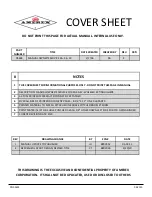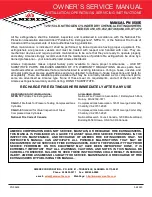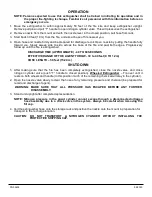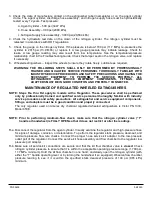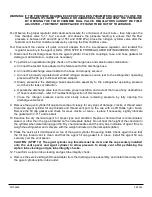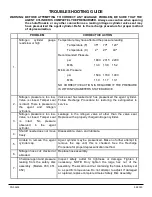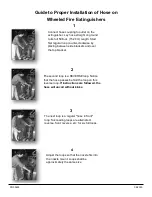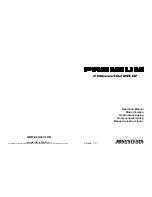
PN 05605
04/2020
b.
Using a regulated nitrogen pressure source, set to the extinguisher operating pressure, slowly and briefly
pressurize the agent cylinder (
the siphon tube shall be clear within a couple of seconds and the
agent cylinder pressure slowly vent from the fill cap thread vent)
. Pressure and/or dry chemical
agent leaks from the gas tube inlet port (where the nitrogen hose connects) will indicate a defective gas
tube and will require that the agent cylinder be emptied and the gas tube replaced.
c.
Close the nitrogen pressure source and allow all pressure to slowly vent from the thread vent port on the
fill cap.
d.
AFTER ALL PRESSURE HAS BEEN RELIEVED,
SLOWLY
OPEN THE FILL CAP, AND
REMOVE THE
TEST KIT VENT SPACER.
e.
Re
-
examine the agent to determine if any obstructions were cleared from the siphon tube and have risen
to the surface.
f.
Clean the fill cap and agent cylinder thread surfaces. Securely install the fill cap gasket and fill cap.
13. Disconnect the high
-
pressure hose from the nitrogen cylinder valve. Securely install the service kit
Nitrogen Cylinder Pressure Check Gauge Assembly to the nitrogen cylinder valve outlet, and verify the
indicated cylinder gauge pressure. Nitrogen pressure shall conform to the temperature correction chart
provided in the Troubleshooting section of this manual. Close the nitrogen cylinder valve and disconnect
the Pressure Check Gauge Assembly.
WARNING: IF THE NITROGEN CYLINDER VALVE HAS A "T" HANDLE QUICK OPENING OR A
HANDWHEEL QUICK OPENING TRIP RELEASE, THE SAFETY VENT PLUG SHIPPED
WITH THE EXTINGUISHER, OR THE TEST KIT SAFETY VENT PLUG MUST BE
INSTALLED TO PROTECT SERVICE PERSONNEL FROM A HIGH VELOCITY
DISCHARGE IN CASE THE LEVER IS ACCIDENTALLY OPENED.
14.
Install a new Amerex Moisture Seal per instructions in the package. Securely connect the discharge hose
to the extinguisher.
When assembling the hose to the agent cylinder or nozzle to the hose, tighten
the coupling ¼ turn after contacting the hose gasket
.
15.
Coil the hose on to the extinguisher hose rack using the Reverse Loop Procedure (see instructions in this
manual). Install shut
-
off nozzle with the lever in the Closed (forward) position into the nozzle mount.
16.
Remove the safety vent plug from the nitrogen cylinder. Reconnect the high
-
pressure hose securely to the
nitrogen cylinder valve. Wipe the extinguisher clean. Record service data on the inspection tag according
to NFPA 10 requirements, and attach to extinguisher. Return extinguisher to its proper location.
RECHARGE
NFPA 10 –
Recharging is the replacement of the extinguishing agent and also includes the expellant
gas for this type of extinguisher.
RECHARGING PROCEDURE
WARNING: BEFORE ATTEMPTING TO RECHARGE, BE SURE THIS EXTINGUISHER IS
COMPLETELY DEPRESSURIZED. THERE IS A CHECK VALVE IN THE SYSTEM,
WHICH PREVENTS NITROGEN PRESSURE FROM ESCAPING FROM THE AGENT
CYLINDER WHEN THE NITROGEN HOSE IS DISCONNECTED. THE AGENT CYLINDER
MAY BE PRESSURIZED EVEN THOUGH NO PRESSURE ESCAPES FROM THE
CYLINDER NITROGEN CONNECTION.
NOTE:
THIS STEP (R
-
d.) IS FOR REGULATED EXTINGUISHERS ONLY
R
-
d. Disconnect the service kit quick connector adapter from the low
-
pressure port of the regulator, and
reinstall the regulator securely to the agent cylinder.

